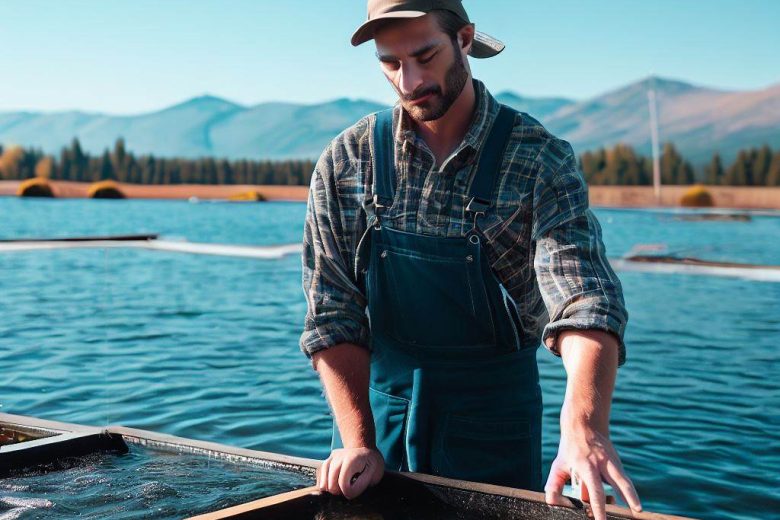Starting a fish farming business in Idaho opens doors to endless possibilities for whoever planning to venture into it. Fish farming is a booming industry that has met the ever-growing demand for fish and fish products.
In particular, the state of Idaho has witnessed a surge in fish farming ventures, capitalizing on its natural resources and economic potential.
From selecting an appropriate site to planning, determining the farming method, to acquiring necessary permits and licenses, to sourcing for funding, selecting the ideal fish species, and so on, every step is crucial for success.
With the right approach and a passion for aquaculture, you can dive into a profitable venture. Get ready to learn the essential strategies, acquire the necessary skills, and unlock the potential of fish farming in Idaho.
How to start a Fish Farming Business in Idaho
By harnessing the abundant natural resources and market demand, you can create a thriving business as a fish farmer in Idaho.
That is why it is important that you take this step by step guide on how to start a fish farming business in Idaho seriously.
We have compiled the tips and guidance on how to start a profitable fish farm business in the following easy steps below.
Read Also: How to Start a Fish Farming Business in Hawaii
Step 1. Select an Appropriate Site
Selecting the right site for your fish farming venture is crucial to its success. The location you choose will impact water quality, environmental sustainability, and overall productivity.
In Idaho, with its diverse landscapes and abundant water resources, finding the perfect site requires careful consideration. Here’s how to select an ideal location for your fish farming endeavor:
- Evaluate Water Availability: Begin by assessing the availability of water on the site. Adequate and reliable water sources, such as rivers, streams, or wells, are essential for maintaining optimal water quality and providing a consistent supply for your fish farm.
- Water Quality Testing: Conduct thorough water quality tests to ensure that the chosen water source meets the requirements for fish farming. Factors such as pH, temperature, dissolved oxygen levels, and contaminants should be within acceptable ranges for your chosen fish species.
- Accessibility: Choose a site that is easily accessible for transportation, equipment delivery, and potential customers. A location with good road connectivity can help streamline operations and reduce logistical challenges.
- Climate Considerations: Take into account the climate of the region. Idaho experiences varying seasons, so select a site where your chosen fish species can thrive in both summer and winter conditions. Consider factors like temperature fluctuations and potential frost.
- Land Topography: Examine the topography of the land to determine whether it’s suitable for fish farming. Flat or gently sloping terrain is generally preferred for creating ponds or tanks that can retain water efficiently.
- Sunlight Exposure: Ensure that the site receives sufficient sunlight throughout the day. Sunlight is essential for promoting the growth of aquatic plants, which contribute to water quality and serve as natural food sources for fish.
- Environmental Impact: Consider the potential environmental impact of your fish farming operation on the surrounding ecosystem. Avoid areas with sensitive habitats or ecosystems that could be negatively affected by fish farm runoff or waste.
- Proximity to Markets: Select a site that is strategically located near potential markets for your fish products. Being closer to consumers can reduce transportation costs and help you establish a strong market presence.
Read Also: How To Start a Fish Farming Business in Georgia
Step 2. Planning
As an aspiring fish farmer, it is important that you outline your goals and strategies.
You can start by defining your objectives and develop an actionable strategy to efficiently reach your desired destination.
Consider important factors such as the fish species you’ll raise, the size of your land or water body, setup expenses, and regulatory requirements.
Decide whether you aim for a profitable business or a hobby farm. Craft a comprehensive business plan that addresses these aspects and more.
Assess the resources needed, outline tasks, establish timelines, budget wisely, and research market trends.
Read Also: How To Start a Fish Farming Business in Delaware
Step 3. Determine the Farming Method
Evaluate the available options, such as backyard ponds, tanks, or aquaponics systems, and consider their suitability for your specific circumstances.
The farming method you will adopt depends greatly on the space you have, the resources at your disposal, and your budget.
Each farming method has its own advantages and considerations, so make an informed decision that best suits your needs.
Step 4. Acquire Necessary Permit and Licenses
Now that you’re progressing with your fish farming business in Idaho, it’s crucial to ensure you have the necessary permits and licenses.
This step is important as others and should not be taken lightly to avoid any challenges with the authorities that may lead to closure or disruption of your business.
Take time to learn about the local regulations and requirements for operating a fish farm in Idaho, and then take the initiative to acquire the appropriate permits and licenses to comply with legal obligations.
Read Also: How to start a Fish Farming Business in Colorado
Consult with local authorities or regulatory bodies to gather the necessary information and complete the application process.
You can checkout this link to learn all you need to know about the permit and licenses required for commercial fish farming in Idaho.
Step 5. Source for Funding
As you forge ahead with your fish farming business, it’s essential to explore various funding options to support your venture.
Evaluate your financial needs and consider different avenues for acquiring funding. Research grants, loans, or investment opportunities that are available for fish farming enterprises.
Also, explore government programs or agricultural initiatives that provide financial support to aspiring farmers.
Develop a solid business plan and financial projections to present to potential investors or lenders, highlighting the viability and profitability of your fish farming business.
Read Also: How to start a Fish Farming Business in California
Step 6. Acquire the Needed Equipment for Fish Farming
As you move forward with your fish farming business in Idaho, it’s time to acquire the necessary equipment to support your operations.
Identify the specific equipment required for fish farming, such as tanks, aerators, water pumps, nets, and feeding systems.
Conduct thorough research to find reputable suppliers or manufacturers who offer high-quality equipment suitable for your needs.
Consider factors such as durability, efficiency, and cost-effectiveness when making your selections.
Ensure that you have the essential tools and machinery to handle tasks such as feeding, water management, and fish handling.
Read Also: [Beginner’s Guide] How to Start a Fish Farming in Arkansas
Step 7. Select and Acquire Desired Fish Species
It’s time to carefully select and acquire the fish species that align with your goals and market demand.
Identify fish species that are known to thrive in the region and have a high potential for profitability.
Consider factors such as their growth rate, tolerance to local climate conditions, and the availability of fingerlings for stocking.
By choosing the right fish species, you can ensure optimal growth and marketability of your products.
In Idaho, some common fish species grown for commercial purposes include Rainbow trout, Steelhead, Cutthroat trout, tuna, and some forms of salmon.
Step 8. Construct your Fishing house
Now that you’re making progress with your fish farming business in Idaho, it’s time to construct the infrastructure for your fish house.
Determine the specific requirements, including the construction of ponds or tanks, installation of water supply systems, aeration equipment, and filtration systems.
Carefully plan the layout of your farm to optimize the available space and ensure easy maintenance.
Consider factors such as the size and number of ponds or tanks needed to accommodate your desired fish stock.
Implement proper design and construction techniques to create a conducive environment for fish growth and health.
Step 9. Stocking and Feeding
This is the stage where you stock your fishes in their houses and feed them with the required food to enhance growth process.
Carefully introduce your fingerlings to their new environment, considering the appropriate stocking densities for the specific fish species and the size of your ponds or tanks.
Avoid overcrowding to prevent stress, disease outbreaks, and potential loss of your investment. Maintain a balance that allows each fish to thrive and grow.
Provide your fish with high-quality, nutritionally balanced feed that meets their dietary requirements.
Ensure that the feed is suitable for the specific fish species you are raising. Monitor their feeding patterns and adjust the amount and frequency of feeding as needed.
Overfeeding can lead to water quality issues and health problems, while underfeeding can hinder growth.
Step 10. Fish Farm Management
Now that your fish farm is up and running, it’s crucial to focus on effective management strategies to ensure the success of your operation. Here are some key considerations.
Water Quality Management
Ensure access to clean water and maintain good water quality by monitoring parameters such as temperature, pH, and oxygen levels. Implement proper filtration and aeration systems to support fish health.
Disease Prevention
Enforce biosecurity protocols to preempt the introduction and proliferation of diseases. Quarantine new fish before adding them to existing stock, monitor fish health regularly, and promptly address any signs of illness.
Routine Maintenance
Regularly maintain and clean your ponds or tanks, monitor water quality, and address any equipment issues. Perform regular inspections to ensure the overall health and well-being of your fish.
Record Keeping
Keep detailed records of your fish farm activities, including stock inventory, feeding schedules, water quality data, and financial transactions. This will help you track performance, identify trends, and make informed decisions.
Step 11. Harvest and Marketing
Once your fish reach the desired size, harvest them using appropriate techniques. Explore local markets, restaurants, or direct sales to sell your fish produce. Develop marketing strategies to promote your products and attract customers.
Benefits of Starting Fish Farming Business in Idaho
Fish farming has great benefits if done properly. The benefits include
- Abundant Natural Resources: Idaho is known for its pristine water bodies, which provide excellent conditions for fish farming. The state offers an abundance of lakes, rivers, and aquifers, providing ample opportunities for fish production.
- Growing Market Demand: Fish and seafood consumption continues to rise, both locally and globally. By starting a fish farming business in Idaho, you can tap into the increasing demand for fresh and sustainably produced fish products.
- Economic Opportunities: Fish farming can contribute to the local economy by creating job opportunities, supporting related industries such as feed suppliers and equipment manufacturers, and generating revenue through sales.
- Diverse Fish Species: Idaho offers a range of fish species suitable for farming, including trout, catfish, tilapia, and more. This diversity allows you to choose species that align with market demand and your farming capabilities.
- Environmental Sustainability: Fish farming can be conducted using sustainable practices, such as recirculating aquaculture systems or integrated aquaponics. These methods minimize water usage, waste production, and environmental impact, ensuring the long-term viability of your business.
Is Fish Farming Business Profitable
Yes, fish farming can be profitable in Idaho. The profitability of your fish farming business depends on various factors, such as market demand, production costs, operational efficiency, and effective marketing strategies.
By implementing sound business practices, optimizing production techniques, and understanding market dynamics, you can maximize the profitability of your fish farming venture in Idaho.
Ideal Locations in Idaho
Idaho offers diverse landscapes and water resources conducive to fish farming. Regions like the Snake River Valley provide suitable conditions for successful fish cultivation.
Industries Utilizing Fish Products
Fish farming products find applications across various sectors, including food and beverage, pet food, pharmaceuticals, and agriculture. This diverse utilization underscores the significance of the fish farming industry.
Optimal Fish Farming Techniques
Efficient fish farming techniques encompass sustainable practices, selective breeding, optimal nutrition, and disease management. These techniques contribute to higher production rates and healthier fish populations.
Common Fish Diseases and Pests
Fish farming is susceptible to diseases and pests that can impact production. Regular health monitoring, proper nutrition, and prompt disease management are essential for preventing and controlling outbreaks.
Marketing Your Fish
Effective marketing strategies are essential for selling your farmed fish. Creating a brand identity, establishing distribution channels, and targeting the right customer segments can enhance the visibility and profitability of your fish products.
Maintenance and Cleaning
Maintaining a clean and healthy environment for your fish is critical. Regular cleaning of tanks or ponds, monitoring water quality, and preventing algae growth are key practices for ensuring the well-being of your fish.
Sourcing Quality Fish Species
Selecting the right fish species for your farm is crucial. Research reputable hatcheries or suppliers that offer healthy and genetically diverse fish varieties suitable for your location and market demand.
Yield per Acre
Estimating the yield of fish per acre involves considering various factors, such as fish species, growth rates, and environmental conditions.
The amount of yield per acre is around $12000 to $20000 USD of fishes. However, careful planning and management can help you optimize yield, making your fish farming venture economically viable.
Fingerlings Suppliers
Sourcing high-quality fingerlings or juvenile fish is the foundation of a successful fish farming business.
Collaborating with reputable suppliers ensures that you start with healthy and genetically diverse fish populations, setting the stage for robust growth.
Challenges Faced when Starting Fish Farming Business in Idaho
Fish farming business is not void of challenges, some of the common challenges faced include:
- Regulatory Compliance: Fish farming operations must adhere to local, state, and federal regulations concerning water usage, environmental impact, and fish health. Complying with these regulations can be complex and may require additional time and resources.
- Capital Investment: Establishing a fish farming business requires significant upfront investment, including land or facility acquisition, equipment purchase, fish stock, and operational costs. Access to adequate funding or financing options can be a challenge for aspiring fish farmers.
- Technical Expertise: Fish farming involves specialized knowledge in areas such as fish health management, water quality monitoring, and feeding strategies. Acquiring the necessary expertise or hiring qualified personnel may pose challenges, particularly for newcomers to the industry.
- Market Competition: The fish farming industry in Idaho is competitive, with established producers and other market participants. Differentiating your products, building strong customer relationships, and developing effective marketing strategies are crucial to overcome market competition.
- Disease Outbreak: Disease outbreaks can pose a significant challenge to fish farming operations. Fish are susceptible to various diseases, and if proper biosecurity measures are not in place, an outbreak can lead to significant losses. It is crucial to implement preventive measures, conduct regular health monitoring, and have a plan in place to address and mitigate disease outbreaks.
Potential Returns
While fish farming demands investments, it offers the potential for substantial returns. Careful planning and diligent management can lead to a profitable venture, making fish farming an attractive business opportunity.
Essential Tools and Inputs
Fish farming requires specific tools and inputs to ensure optimal conditions for fish growth. From aeration systems to water testing kits, having the right equipment and resources is crucial for maintaining a healthy and productive fish farm.
Risks in Fish Farming
Like any business, fish farming comes with its share of risks. Environmental factors, disease outbreaks, market fluctuations, and regulatory challenges are some of the risks that fish farmers need to be prepared to manage.
Profitability of Fish Farming
The profitability of a fish farming business depends on several factors, including operational efficiency, market demand, and management practices.
Factors to Consider when Starting Fish Farming Business in Idaho
- Water Source: Access to a reliable and quality water source is essential for fish farming. Consider the availability and suitability of water bodies, such as ponds, lakes, or wells, to meet the needs of your fish farming operation.
- Fish Species Selection: Research and choose fish species that are well-suited to Idaho’s climate, market demand, and your farming capabilities. Consider factors such as growth rate, disease resistance, and local market preferences when selecting fish species for your farm.
- Farming Method: Decide on the farming method that aligns with your resources, goals, and market demand. Options include pond farming, tank-based systems, recirculating aquaculture systems (RAS), or even aquaponics, which combines fish farming with plant cultivation.
- Market Analysis: Conduct thorough market research to understand the demand, pricing, and potential customers for your fish produce. Identify potential buyers, such as local restaurants, grocery stores, farmers markets, or direct consumers, and evaluate their preferences and requirements.
Best Practices for Starting Fish Farming Business in Idaho
- Start Small: Begin with a manageable scale and gradually expand as you gain experience and market demand increases. Starting small allows you to minimize risks, learn the intricacies of fish farming, and refine your techniques before scaling up.
- Maintain Water Quality: Monitor and maintain optimal water quality parameters, including temperature, dissolved oxygen levels, pH, and ammonia levels. Implement proper filtration and aeration systems to ensure a healthy and conducive environment for fish growth.
- Disease Prevention and Management: Implement biosecurity measures to prevent disease outbreaks. Quarantine new fish stock, practice proper sanitation, and monitor fish health regularly. Consult with local fish health experts or extension agencies for guidance on disease prevention and management.
- Financial Management: Develop a sound financial plan, including budgeting, cost estimation, and pricing strategies. Keep accurate records of expenses, income, and production data to track profitability and make informed business decisions.
Where to Sell Fish Produce
- Local Markets: Consider selling directly to local consumers through farmers markets, community-supported agriculture (CSA) programs, or roadside stands. Build relationships with local restaurants, grocery stores, and seafood retailers to explore potential partnerships.
- Wholesale Buyers: Connect with wholesale buyers, including seafood distributors, fish markets, and food service companies. They may purchase your fish produce in larger quantities for distribution to restaurants, hotels, and other establishments.
- Online Platforms: Utilize online platforms, such as e-commerce websites or social media, to market and sell your fish produce directly to consumers. Create an online presence, showcase your products, and offer convenient delivery or pickup options.
Cost of Starting Fish Farming Business in Idaho
Fish farming business can be capital intensive considering the items and equipment needed to run the business.
On the average, starting a business in fish farming in Idaho will cost you an average of $20,000 to $30,000 considering land acquisition, operational cost, equipment and supplies, pond construction, and so on.
Starting a Small-Scale Fish Farm
If you’re considering diving into the world of fish farming on a smaller scale, Idaho offers a fertile ground for turning your backyard or small piece of land into a thriving fish cultivation venture.
While commercial fish farming often involves larger operations, starting small has its own unique benefits and challenges.
Below is step-by-step guide to help you get started with your small-scale fish farm:
- Research and Planning: Begin by researching the types of fish species that are well-suited for your region in Idaho. Consider factors such as water temperature, quality, and local regulations. Create a comprehensive business plan that outlines your goals, target market, estimated costs, and projected profits.
- Selecting Fish Species: Choose fish species that are well-adapted to your local climate and available resources. Some popular choices for small-scale fish farming in Idaho include trout, catfish, and perch. Research the specific requirements of each species in terms of water conditions, feed, and growth rates.
- Setting Up Tanks or Ponds: Depending on the available space and resources, decide whether you’ll be using tanks or ponds for your fish farm. Ensure that the location you choose receives adequate sunlight and protection from harsh weather conditions.
- Water Quality Management: Maintaining optimal water quality is paramount for the health and growth of your fish. Regularly test water parameters such as pH, ammonia levels, and oxygen content. Implement filtration and aeration systems to keep the water clean and well-oxygenated.
- Feeding and Nutrition: Provide a balanced and nutritious diet for your fish. Research the dietary requirements of your chosen fish species and select appropriate feed. Monitor feeding schedules and adjust portion sizes as the fish grow.
- Stocking Density: Avoid overcrowding by adhering to recommended stocking densities. A well-spaced environment promotes healthier fish and better growth rates.
- Disease Prevention and Management: Regularly inspect your fish for signs of disease. Quarantine new fish before introducing them to your existing stock to prevent the spread of potential diseases. Educate yourself about common fish diseases and their treatments.
Starting a Commercial Fish Farm
If you’re ready to take fish farming to a commercial level, Idaho’s abundant water resources and favorable business environment make it an ideal location.
Starting a commercial fish farm involves larger investments, more significant infrastructure, and broader market considerations.
Here’s a comprehensive guide to launching your commercial fish farming business in Idaho:
- Market Research and Business Plan: Conduct thorough market research to identify demand for specific fish species in Idaho and beyond. Develop a detailed business plan that outlines your production goals, marketing strategies, operational costs, and revenue projections.
- Selecting Fish Species and Scaling Up: Choose fish species based on market demand and suitability for Idaho’s conditions. Prepare for larger-scale operations by investing in tanks, ponds, or raceways that can accommodate higher fish populations.
- Obtaining Permits and Regulations: Navigating regulatory requirements is crucial for commercial fish farming. Obtain the necessary permits, licenses, and approvals from local and state authorities. Compliance with environmental and health regulations is essential.
- Infrastructure Development: Invest in infrastructure such as tanks, filtration systems, aeration systems, and water management facilities. Design the layout of your fish farm to optimize space, water flow, and accessibility.
- Staffing and Training: As your operation grows, you may need to hire skilled personnel to assist with daily tasks such as feeding, water quality management, and maintenance. Ensure that your staff is trained in fish husbandry practices and disease management.
- Supply Chain Management: Establish reliable sources for fish feed, fingerlings, and equipment. Build relationships with suppliers who can provide high-quality inputs for your fish farming operation.
- Marketing and Distribution: Develop a marketing strategy to promote your fish products to wholesalers, retailers, and consumers. Consider creating an online presence, participating in local markets, and establishing partnerships with restaurants and grocery stores.
- Financial Management: Monitor your finances closely by tracking expenses, revenue, and profitability. Set up an accounting system to keep accurate records of all transactions and operational costs.
- Risk Management: Commercial fish farming comes with inherent risks, including disease outbreaks, market fluctuations, and weather-related challenges. Prepare contingency plans to mitigate these risks to ensure the continuity of your business.
Requirements For Fish Farming
The specific requirements for fish farming can vary depending on the location, scale, and type of fish farming operation.
However, there are some common requirements to consider:
- Suitable Land or Water Source: You will need access to land or a suitable water source such as a pond, lake, or controlled recirculating system. The size and quality of the land or water source should be appropriate for the fish species you plan to raise.
- Regulatory Permits and Licenses: Check with local authorities and regulatory agencies to understand the permits and licenses required for fish farming in your area. This may include water use permits, environmental permits, and fish health certifications.
- Water Quality Management: Adequate water quality is crucial for the health and growth of fish. You will need to monitor and maintain water parameters such as temperature, dissolved oxygen levels, pH, and ammonia levels to ensure optimal conditions for the fish.
- Feeding and Nutrition: Develop a feeding program based on the nutritional needs of the fish species you are farming. Ensure a balanced and appropriate diet to support growth and maintain good health.
- Disease Prevention and Management: Implement biosecurity measures to prevent the introduction and spread of diseases in your fish farm. This may include quarantine procedures for new fish stock, regular health checks, and appropriate vaccinations or treatments when necessary.
- Farm Infrastructure and Equipment: Depending on the scale of your operation, you may need infrastructure such as ponds, tanks, nets, aeration systems, water pumps, and filtration equipment. Ensure that you have the necessary equipment and facilities for the efficient operation of your fish farm.
- Knowledge and Skills: Gain the necessary knowledge and skills in fish farming through training programs, workshops, or consulting with experienced fish farmers. Understanding fish biology, water management, feeding practices, and disease prevention will contribute to the success of your fish farming venture.
Fish Farming Business Plan Pdf
Fish farming business plan PDF is an ideal document designed to help you when writing your fish farming business plan.
Check out this link to access a fish farming business plan PDF template https://southcenters.osu.edu/sites/southc/files/site-library/site-documents/abc/aquaculturebusinessplan.pdf
How Much Do Fish Farmers Make A Year
On the average, fish farmers take home in a year ranges from $30,000 to $70,000.
Fish Farming Business For Sale
To learn of any fish farming business that is for sale, the best way is to surf the internet and you will be provided with many options including some near you.
You can visit https://everything-for-business.com/business-for-sale/fish-farms for a start.
Conclusion
Starting a fish farming business in Idaho requires careful planning, adequate resources, and adherence to regulations. Consider factors such as suitable land or water sources, necessary permits, water quality management, fish stock selection, disease prevention, infrastructure, and acquiring the needed knowledge. With proper preparation, you can embark on a successful and profitable fish farming venture in Idaho.





3 Replies to “How to start a Fish Farming Business in Idaho”